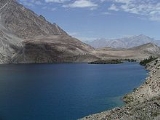
Water resources management in Pakistan
Encyclopedia

Pakistan
Pakistan , officially the Islamic Republic of Pakistan is a sovereign state in South Asia. It has a coastline along the Arabian Sea and the Gulf of Oman in the south and is bordered by Afghanistan and Iran in the west, India in the east and China in the far northeast. In the north, Tajikistan...
.
Water resources
According to the United Nations' "UN World Water Development ReportUN World Water Development Report
The United Nations World Water Development Report is a global report that provides an authoritative, comprehensive assessment of the world’s freshwater resources...
", the total actual renewable water resources decreased from 2,961 m³ per capita in 2000 to 1,420 m³ per capita in 2005. A more recent study indicates an available supply of water of little more than 1,000 m³ per person, which puts Pakistan in the category of a high stress country. Using data from the Pakistani federal government's Planning and Development Division, the overall water availability has decreased from 1,299 m³ per capita in 1996-97 to 1,101 m³ per capita in 2004-05. In view of growing population
Population growth
Population growth is the change in a population over time, and can be quantified as the change in the number of individuals of any species in a population using "per unit time" for measurement....
, urbanization
Urbanization
Urbanization, urbanisation or urban drift is the physical growth of urban areas as a result of global change. The United Nations projected that half of the world's population would live in urban areas at the end of 2008....
and increased industrialization, the situation is likely to get worse. Nevertheless, excessive mining of groundwater goes on. Despite a lowering water table
Water table
The water table is the level at which the submarine pressure is far from atmospheric pressure. It may be conveniently visualized as the 'surface' of the subsurface materials that are saturated with groundwater in a given vicinity. However, saturated conditions may extend above the water table as...
, the annual growth rate of electric tubewells
Water well
A water well is an excavation or structure created in the ground by digging, driving, boring or drilling to access groundwater in underground aquifers. The well water is drawn by an electric submersible pump, a trash pump, a vertical turbine pump, a handpump or a mechanical pump...
has been indicated to 6.7% and for diesel tubewells to about 7.4%. In addition, increasing pollution and saltwater intrusion
Saltwater intrusion
Saltwater intrusion is the movement of saline water into freshwater aquifers. Most often, it is caused by ground-water pumping from coastal wells, or from construction of navigation channels or oil field canals. The channels and canals provide conduits for salt water to be brought into fresh...
threaten the country's water resources. About 36% of the groundwater
Groundwater
Groundwater is water located beneath the ground surface in soil pore spaces and in the fractures of rock formations. A unit of rock or an unconsolidated deposit is called an aquifer when it can yield a usable quantity of water. The depth at which soil pore spaces or fractures and voids in rock...
is classified as highly saline.
In urban areas, most water is supplied from groundwater except for the cities of Karachi, Hyderabad and a part of Islamabad, where mainly surface water is used. In most rural areas, groundwater is used. In rural areas with saline groundwater, irrigation canals serve as the main source of domestic water.
Water use
Out of the 169,384 billion m³ of water which were withdrawn in 2000, 96% were used for agricultural purposes, leaving 2% for domestic and another 2% for industrial use. By far most water is used for irrigatedIrrigation
Irrigation may be defined as the science of artificial application of water to the land or soil. It is used to assist in the growing of agricultural crops, maintenance of landscapes, and revegetation of disturbed soils in dry areas and during periods of inadequate rainfall...
agriculture, emphasizing the particular significance of agriculture in the country. The sector contributes about 25% of the Pakistan's GNP
GNP
Gross National Product is the market value of all products and services produced in one year by labor and property supplied by the residents of a country...
(2000-2001). The country still has the world's largest contiguous irrigation system. In 1999-2000, the total irrigated area in Pakistan was 181,000 km².
Water is also essential for power generation in Pakistan, since about 29% is generated through hydropower
Hydropower
Hydropower, hydraulic power, hydrokinetic power or water power is power that is derived from the force or energy of falling water, which may be harnessed for useful purposes. Since ancient times, hydropower has been used for irrigation and the operation of various mechanical devices, such as...
.

